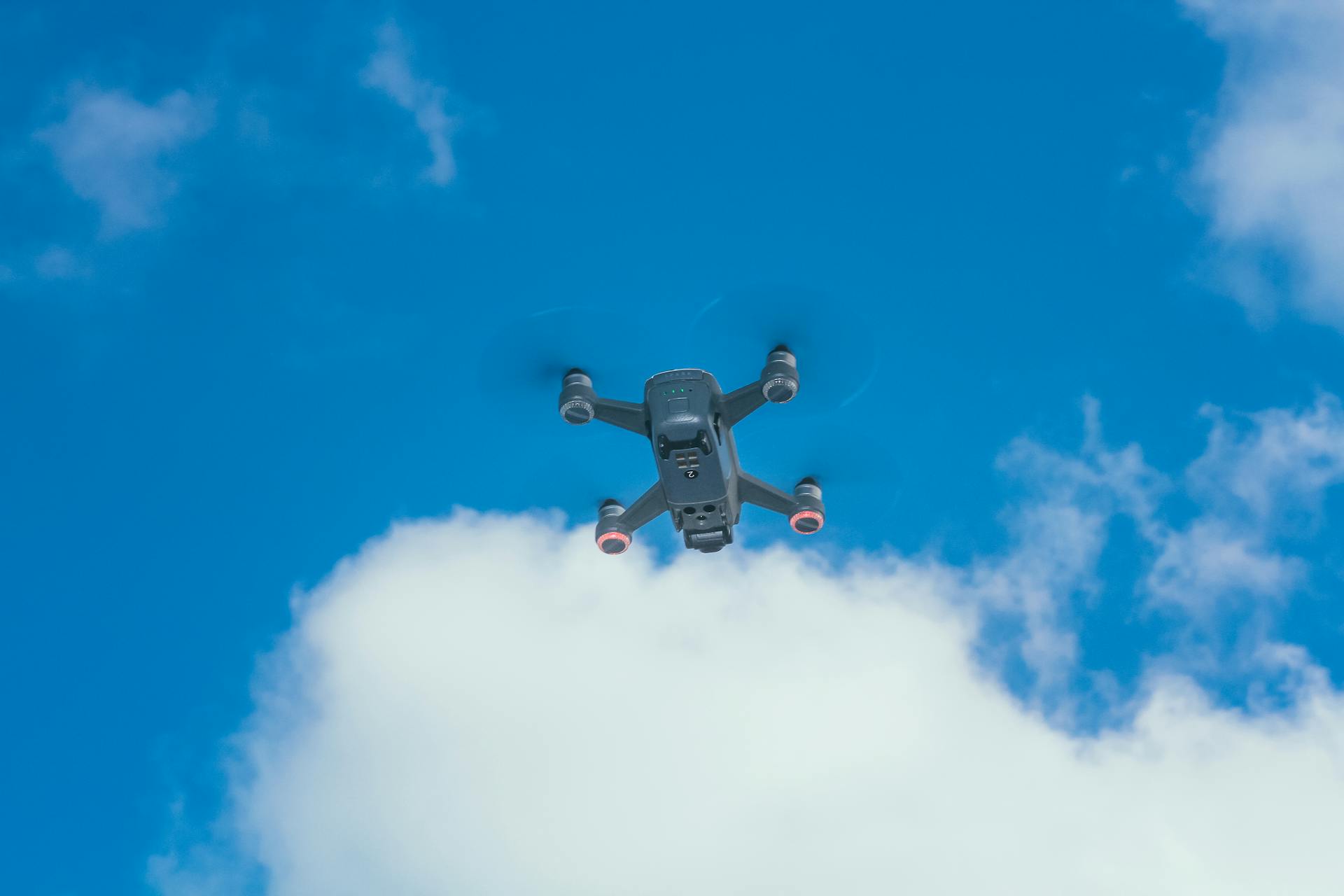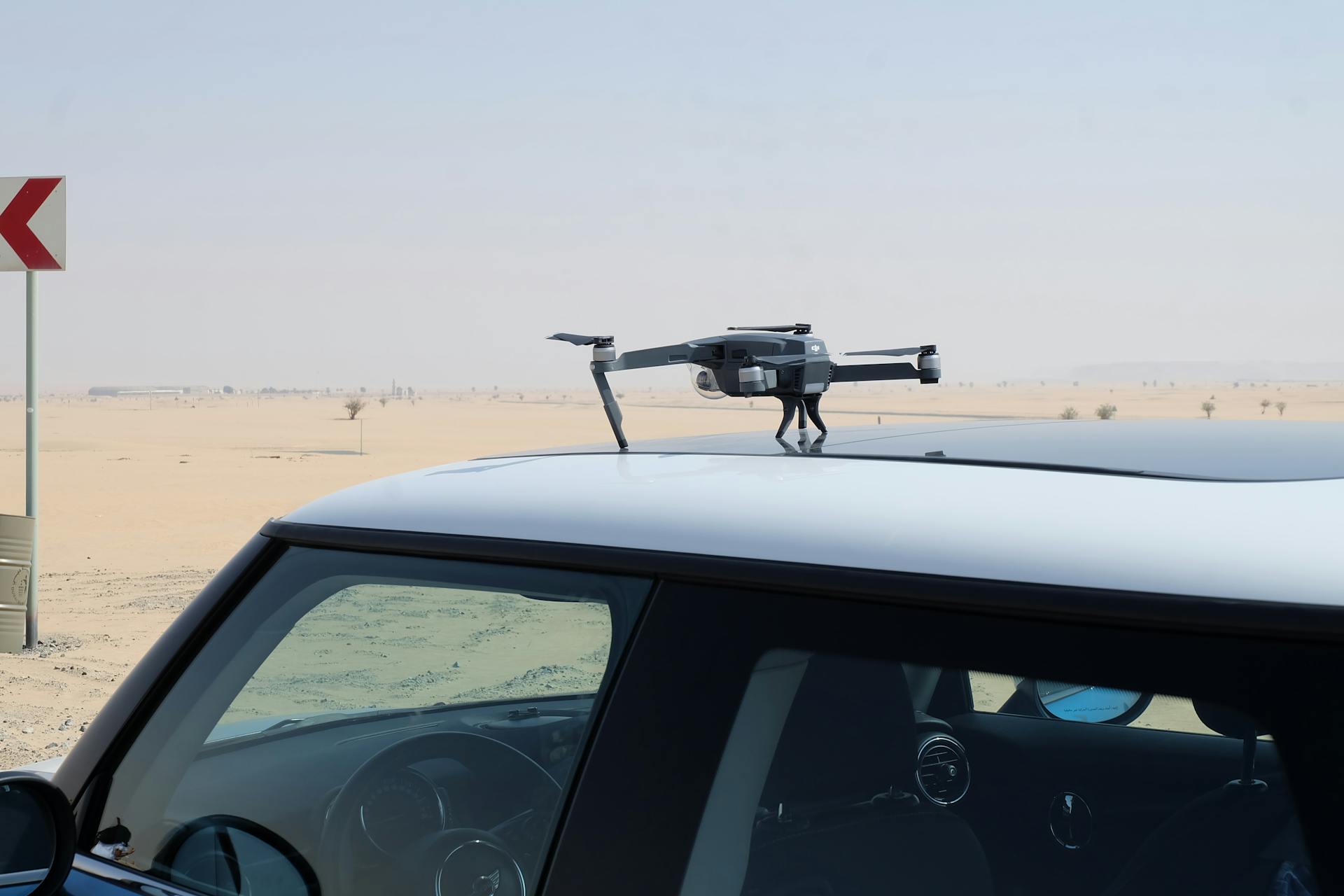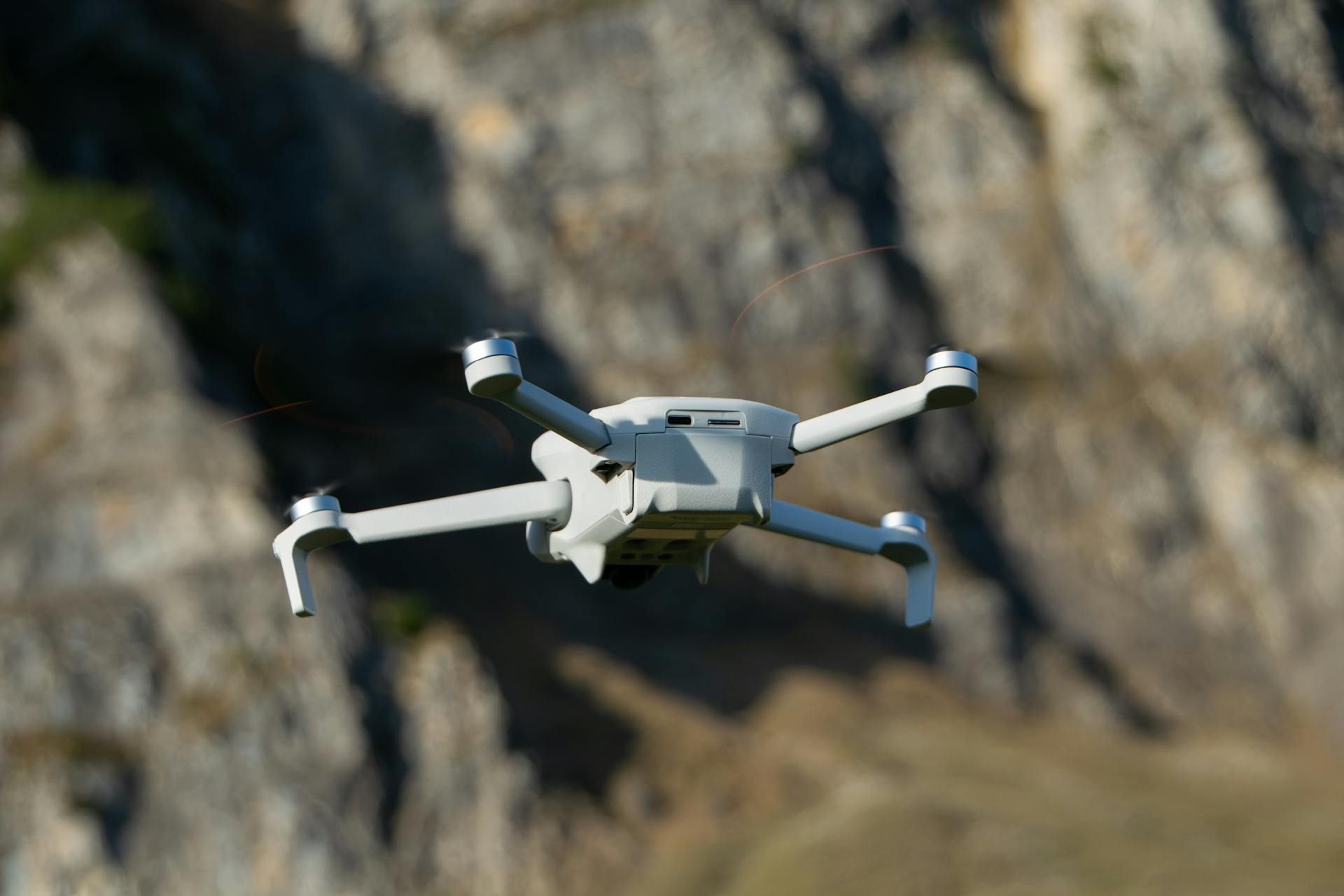
The history of UAVs is a fascinating story that spans several decades. The first recorded use of UAVs dates back to 1916.
In the 1950s, the US Navy developed the Raven, a radio-controlled drone used for target practice. This marked the beginning of UAV development in the military.
The first successful flight of a UAV was made by the US Navy's project in 1964. This achievement paved the way for further research and development of UAVs.
The 1990s saw a significant increase in UAV research and development, with the US military investing heavily in UAV technology.
Related reading: Military Drone Swarm
Early History
The early history of UAVs is a fascinating story that dates back to the 19th century. In 1849, the Austrian military used unmanned balloons loaded with explosives to attack Venice, Italy, marking the first recorded military use of drones.
The use of unmanned balloons was largely ineffective due to the wind shifting and most missing their target. The first mass-produced UAV product in the U.S. was the Radioplane OQ-2, a remote-controlled model airplane developed by British actor Reginald Denny and engineer Walter Righter in the 1930s.
Other significant leaps forward in military drone technology occurred between 1930-1945, including the development of the Curtiss N2C-2 Drone in 1937 and the British "Queen Bee" target drone in 1935.
Consider reading: Use of UAVs in Law Enforcement
RC Planes Gained Popularity in the 1960s and 1970s
Recreational RC planes became prominent during the 1960s and 1970s thanks to breakthroughs in transistor technology that made radio-controlled components affordable for civilian customers.
The miniaturization of radio-controlled components led to a boom in RC planes during this decade, with planes becoming available in kit form for enthusiasts to build and fly indoors or outdoors.
Hobbyists started a large number of RC aircraft clubs, creating a cottage industry that would speed up the development of commercial RC technology.
Planes in kit form allowed enthusiasts to build and fly RC craft, giving them a sense of ownership and control over their flying experience.
The popularity of RC planes during this time paved the way for further advancements in drone technology, which would eventually lead to the modern drones we know today.
1917 Aerial Torpedo
In 1917, Charles F. Kettering of Dayton, Ohio created the first unmanned aerial torpedo for the US Army.
The Kettering Aerial Torpedo, also known as the "Bug", had a maximum speed of approximately 50 mph.
Test flights of the Bug gave mixed results, and it was never used in combat.
Fewer than 50 Bugs were produced, and a full-size reconstruction is on display at the National Museum of the United States Air Force in Dayton, Ohio.
1935 The Modern
In 1935, the British Royal Navy introduced the de Havilland DH82B "Queen Bee", a remotely controlled aircraft used for target practice.
The Queen Bee is considered one of the first modern drones and marked the beginning of the drone technology program in the United Kingdom.
412 of the DH82B were built, making it a significant milestone in drone history.
The Queen Bee's development led to the use of the term "drone" to describe radio-controlled unmanned aircraft, a term that has stuck to this day.
The British "Queen Bee" was also believed to have contributed to the development of further drone technology, paving the way for future advancements.
Expand your knowledge: Define Drone Aircraft
Military Development
The first recorded military use of drones was in 1849, when the Austrian military used unmanned balloons loaded with explosives to attack Venice, Italy, although they were largely ineffective.
The US first deployed reconnaissance UAVs at a large scale during the Vietnam War in 1964, with over 3,400 drones deployed and each completing an average of three missions before being lost.
In the 1930s, the U.S. Navy began experimenting with radio-controlled aircraft, resulting in the development of the Curtiss N2C-2 Drone in 1937, and the British developed the "Queen Bee", a radio-controlled target drone, in 1935.
The Radioplane OQ-2, a remote-controlled model airplane developed in the 1930s, became the first mass-produced UAV product in the US, with nearly 15,000 drones manufactured for the military during the war.
The German army's V-1 "Doodlebugs" were the world's first-ever cruise missiles, used in a campaign of "terror bombing" in British cities like London during World War II.
The V-1 "Doodlebugs" used a simple autopilot to control altitude and airspeed, and gyros, rudder, and elevator were controlled using pressurized air.
The US also developed pulsejet-powered unmanned aerial drones like the TD2D-1 Katydid and Curtiss KD2C, which were reverse-engineered from the German technology.
The RQ2 Pioneer, a medium-sized reconnaissance aircraft, was developed in 1986 as a joint project between the US and Israel, and it became one of the first widely used drones in modern warfare.
The MQ-1 Predator, released in 1996, became one of the most iconic military drones, known for its role in reconnaissance and targeted strikes.
A unique perspective: Dji Inspire 1 Uav
1943 First-Person View Aircraft
In 1943, the U.S. Air Force and Boeing collaborated on the BQ-7, an early attempt at a first-person view flight system.
The BQ-7 was integrated into modified bombers, stripped of non-essential equipment and loaded with explosives, to create a crude FPV technology.
A human pilot would manually fly the aircraft toward a target and then engage the autopilot to continue on its path autonomously.
The BQ-7 proved largely ineffective in warfare, with many pilots dying or being captured after bailing out.
Despite its challenges, the BQ-7 highlighted the potential and significant challenges of remotely controlled aerial systems.
The German military also developed the V-1 flying bomb, an early cruise missile with a first-person view system, during World War II.
This technology allowed operators to guide the missile to its target using a live video feed.
See what others are reading: First-person View (radio Control)
Assault Military Beefed Up 1980-1989
The 1980s saw a significant boost in the development of assault military drones. The US began the Pioneer UAV Program in 1980 to build an inexpensive drone for fleet operations.
The Israeli forces made a breakthrough in 1982 by using unmanned aircraft to gain a victory over the Syrian Air Force with minimal losses. This victory marked a turning point in the perception of drones as unreliable and expensive.
The US and Israel collaborated on a joint project in 1986, resulting in the development of the RQ2 Pioneer, a medium-sized reconnaissance aircraft. This drone became one of the first widely used drones in modern warfare.
Drones during this period also began to focus on alternative power sources, with solar power being a notable option. The AeroVironment HALSOL was an example of a solar-powered drone developed during this time.
See what others are reading: Indian Drone Aircraft
Aerial Target Practice in Pilot Training
Aerial target practice is a crucial aspect of pilot training, allowing human pilots to hone their skills in a safe and realistic environment.
The U.S. military has used converted F-4 Phantoms as aerial targets since 1997, with over 80 of these planes serving in this role.
These robotic planes provide a challenging and dynamic target for pilots to engage, helping to improve their accuracy and reaction time.
In 2013, F-16s were introduced as more realistically maneuverable targets, further enhancing the effectiveness of aerial target practice.
The use of these converted fighter jets has become an essential component of pilot training, allowing military personnel to develop and refine their skills in a controlled and simulated environment.
Historical Events
In 1981, the Israeli IAI Scout drone was operated in combat missions by the South African Defence Force against Angola during Operation Protea.
The Israeli Air Force used UAVs in Operation Mole Cricket 19 in 1982, where the IAI Scout and Tadiran Mastiff were used to identify SAM sites, while Samson decoy UAVs were used to activate and confuse Syrian radar.
The first US targeted UAV killing outside the conventional battlefield took place on November 3, 2002, in the Marib district of Yemen, where six alleged terrorists were killed in their SUV by a UAV-fired missile.
In December 2002, the first ever dogfight involving a UAV occurred when an Iraqi MiG-25 and a US RQ-1 Predator fired missiles at each other, with the MiG's missile destroying the Predator.
The US deployed UAVs in Yemen to search for and kill Anwar al-Awlaki, an American and Yemen imam, firing at and failing to kill him at least once before he was killed in a UAV-launched missile attack in Yemen on September 30, 2011.
Here's a list of notable historical events involving UAVs:
- 1981: Israeli IAI Scout drone operated in combat missions by the South African Defence Force against Angola during Operation Protea.
- 1982: Israeli Air Force used UAVs in Operation Mole Cricket 19 to identify SAM sites and confuse Syrian radar.
- 2002: First US targeted UAV killing outside the conventional battlefield took place in Yemen.
- 2002: First ever dogfight involving a UAV occurred between an Iraqi MiG-25 and a US RQ-1 Predator.
- 2011: US deployed UAVs in Yemen to search for and kill Anwar al-Awlaki, an American and Yemen imam.
Modern Era
The Modern Era of UAVs has been a game-changer. The last ten years have seen a huge explosion in drone innovation and commercial interest.
Drones are no longer just for military purposes or hobbyists; they're now being used in a variety of ways, including as delivery vehicles. This rapid growth in usage has led to a massive increase in demand for drone permits, with around 1000 commercial drone permits issued in 2015.
The use of drones with cameras is now commonplace in commercial photography and videography, thanks to the merging of radio-controlled aircraft and smartphone technology. This has made it easier and more affordable to capture high-quality footage and photos.
The growth in smartphone technology has also reduced the prices of microcontrollers, accelerometers, and camera sensors, making them ideal for use in fixed-wing hobbyist aircraft.
2010-Today: The Golden Age
The "Golden Age" of drones began around 2010 and has been characterized by rapid innovation and commercial interest. This period saw a huge explosion in drone development, with new uses emerging beyond their traditional military and hobbyist applications.
The FAA issued around 1000 commercial drone permits in 2015, a number that tripled the following year. Since then, the growth in demand for drone permits has continued to accelerate exponentially.
Equipping drones with cameras has become commonplace in commercial photography and videography, thanks to the merging of radio-controlled aircraft and smartphone technology. The rapid growth in smartphone usage reduced the prices of essential components like microcontrollers, accelerometers, and camera sensors.
Improving the stability of multirotor aircraft has opened up new possibilities for their use, including surveillance by police forces and fire services. DIY drones, with their smaller size and portability, are also becoming increasingly popular.
Degree of Autonomy
The concept of autonomy in modern drones has a fascinating history. The British Royal Navy introduced the de Havilland DH82B "Queen Bee", a remotely controlled aircraft used for target practice, in 1935.
This marks the beginning of the drone technology program in the United Kingdom, with 412 of the DH82B being built. The Queen Bee is considered one of the first modern drones.
The degree of autonomy in these early drones was largely dependent on the level of remote control allowed by the operator. The Queen Bee's design reflected this, with the ability to be controlled from a distance of up to 10 miles.
US Military Tiers
The US military has established a tier system for unmanned aerial vehicles (UAVs) to categorize their capabilities and roles. This system helps to ensure that each branch of the military has a clear understanding of the UAVs they are using.
The US Air Force has a tier system with four main categories: Tier I, II, II+, and III-. Tier I UAVs are designed for low-altitude, long-endurance missions, while Tier II UAVs are medium-altitude, long-endurance (MALE) aircraft. The MQ-9 Reaper and MQ-1 Predator currently fill the Tier II role.
Here's an interesting read: High Altitude Long Endurance Uav
Here's a breakdown of the US military's UAV tier system:
The US Army's Tier III UAVs, for example, are designed for medium-range tactical missions, which is currently filled by the MQ-5A/B Hunter and IGNAT/IGNAT-ER.
Permitted in US Civilian Airspace
In 2006, the United States Federal Aviation Administration (FAA) began allowing the use of UAVs in civilian airspace under specific regulations, marking the beginning of the widespread use of drones in the United States. This move paved the way for the integration of drones into various industries and applications.
The FAA's decision to permit UAVs in civilian airspace was a significant milestone in the development of drone technology. It opened up new opportunities for commercial and recreational use of drones.
The widespread use of drones in the United States has been a gradual process, starting with the FAA's 2006 regulations. Since then, the use of drones has become increasingly common in various sectors, including photography, filmmaking, and surveying.
The FAA's regulations for UAVs in civilian airspace are designed to ensure safe and responsible use of drones. These regulations include specific guidelines for drone operation, maintenance, and safety protocols.
You might enjoy: Regulation of UAVs in the United States
US Military Tiers
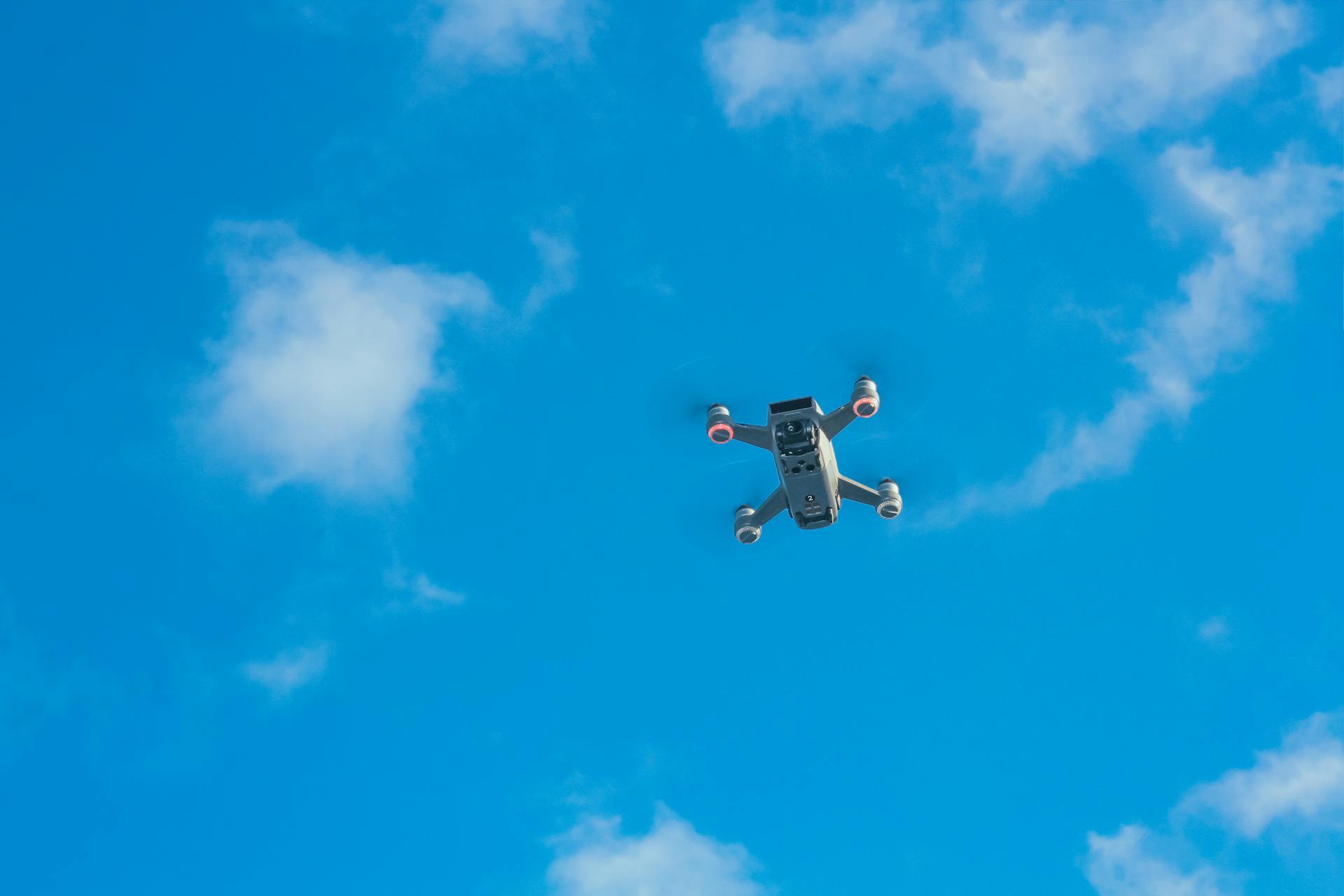
The US military has a tiered system for its unmanned aerial vehicles (UAVs), with each branch having its own set of tiers. This system helps to categorize and assign roles to different types of UAVs.
The US Air Force has a Tier I UAV that operates at low altitude and has long endurance, filled by the Gnat 750. The Tier II UAV has medium altitude and long endurance, filled by the MQ-1 Predator and MQ-9 Reaper.
The US Army has a Tier I UAV that's small in size, filled by the RQ-11B Raven. The Tier II UAV has short range and tactical capabilities, filled by the RQ-7B Shadow 200.
The US Marine Corps has a Tier I UAV that's currently filled by the RQ-11B Raven B, replacing the Dragon Eye.
Here's a breakdown of the US military's UAV tiers:
The Tier III UAV in the US Air Force and Army has high altitude and long endurance capabilities, with the RQ-4 Global Hawk and MQ-5A/B Hunter filling this role. The US Marine Corps has also transitioned to the RQ-7 Shadow for its Tier III UAV.
U.S. Army FCS Classes
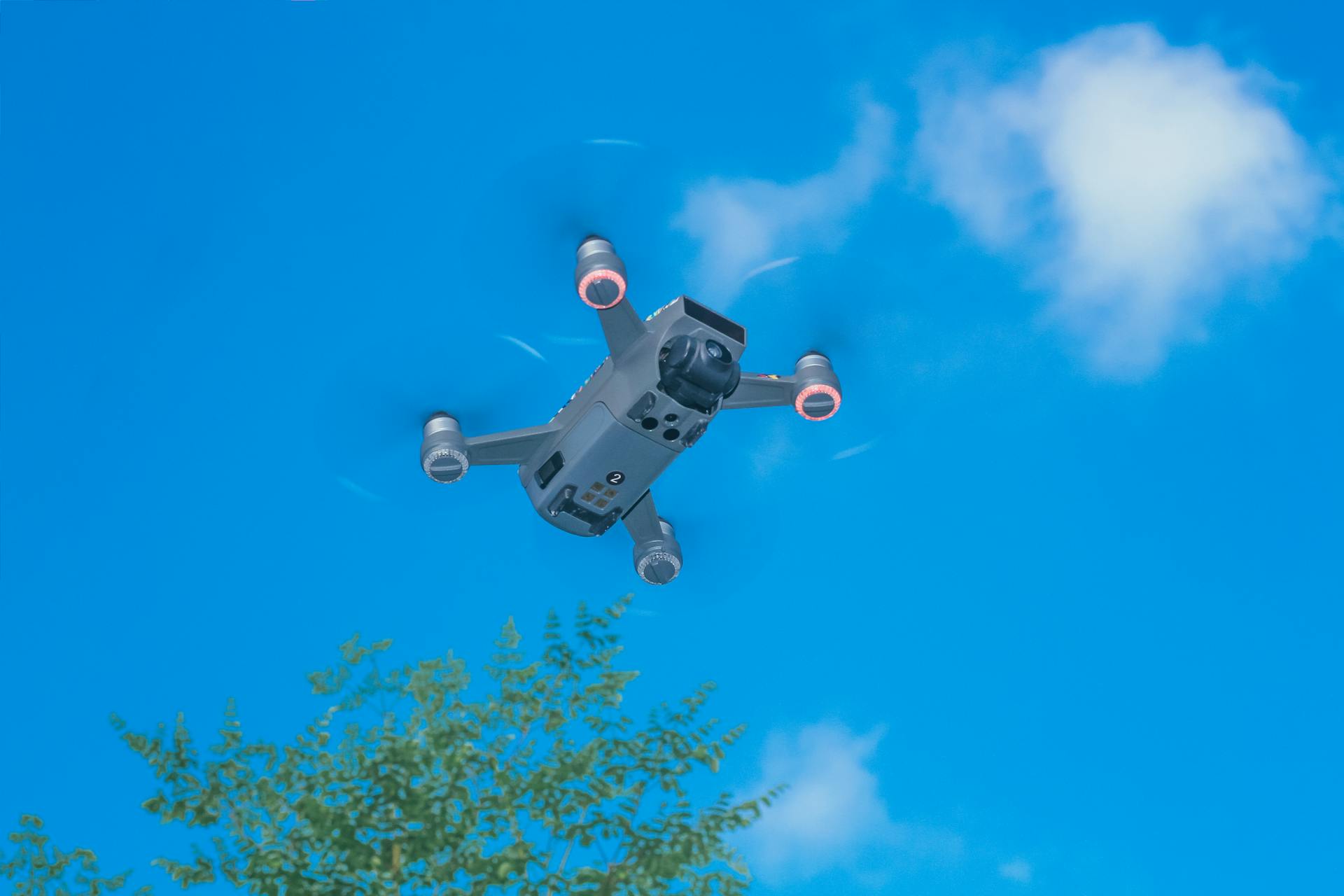
The U.S. Army FCS classes are an interesting example of how military units are organized and equipped.
The U.S. Army FCS classes are a system used to categorize and assign roles to different types of units.
One of the classes, Class I, is designed for small units.
This class will be filled by new UAVs with some similarity to micro air vehicles.
Class II was initially intended for companies, but it was cancelled.
Similarly, Class III was also meant for battalions, but it too was cancelled.
Class IV, on the other hand, is designed for brigades.
The RQ-8A/B / MQ-8B Fire Scout will fill this role.
Here's a breakdown of the U.S. Army FCS classes:
Across the US
Across the US, the US Military Tiers system is implemented differently in various branches. The Army, for example, is divided into four tiers: Private, Private Second Class, Specialist/Corporal, and Sergeant.
The Marine Corps, on the other hand, has a three-tier system: Private, Lance Corporal, and Staff Sergeant. This tier system is used to determine pay, benefits, and promotions.
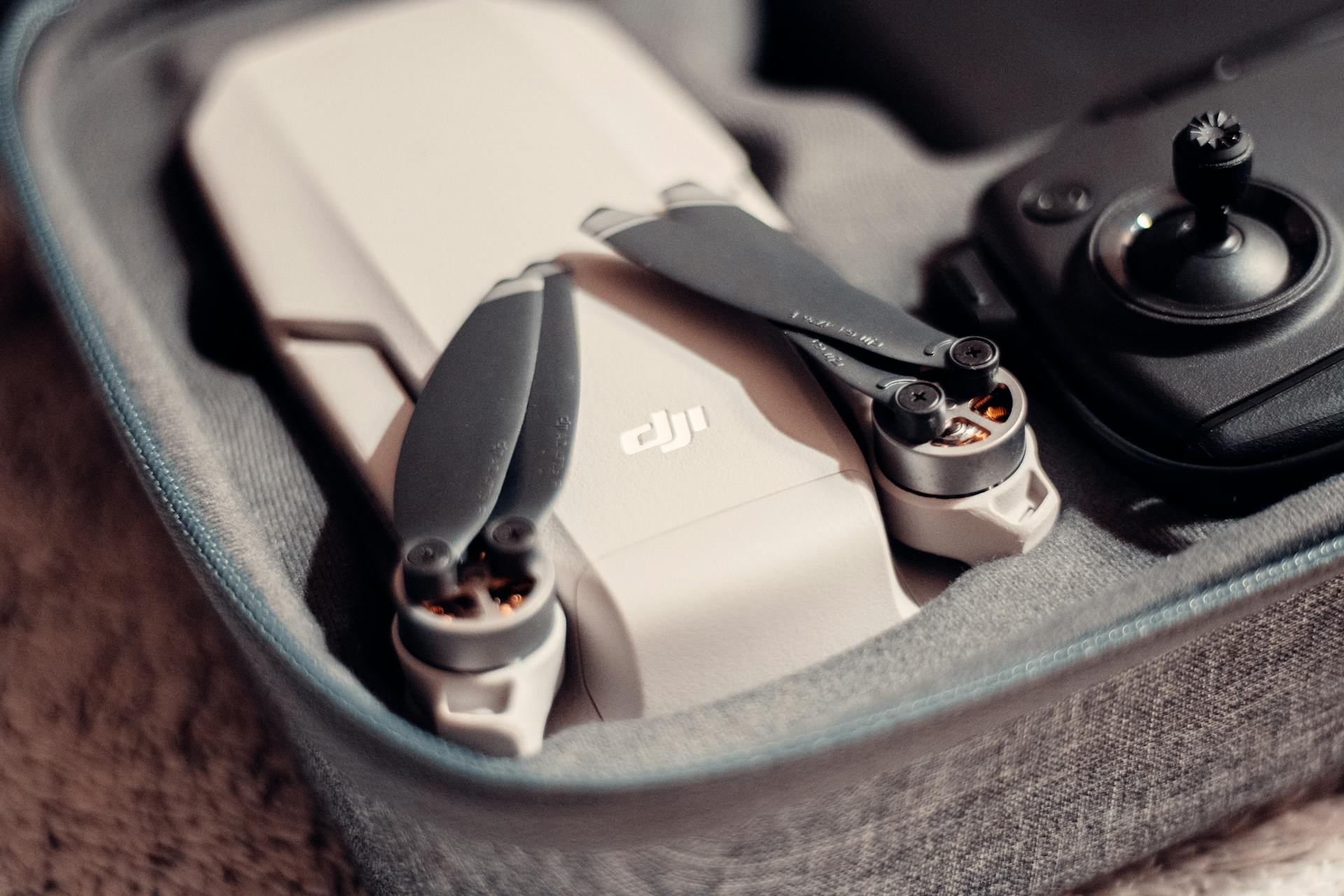
The Navy's tier system is more complex, with 13 enlisted pay grades and 10 warrant officer pay grades. Each pay grade has its own set of responsibilities and requirements.
The Air Force's tier system is based on the Air Force Specialty Code (AFSC), which determines an airman's job and responsibilities. The AFSC is used to determine pay and promotions.
In general, the US Military Tiers system is designed to recognize and reward experience, skills, and leadership abilities.
Broaden your view: Micro Air Vehicles
Surveillance and Policing
In the US military, surveillance and policing are crucial aspects of maintaining order and security. The military uses advanced technology to monitor and track individuals, including drones and satellite imaging.
The US military has a strong presence in Afghanistan, where they have been involved in counterinsurgency efforts. This has led to the development of specialized units, such as the 101st Airborne Division, which have been trained in counterinsurgency tactics.
Surveillance is a key component of policing in the US military, with units like the 1st Special Forces Operational Detachment-Delta (1st SFOD-D) using advanced surveillance techniques to gather intelligence. The 1st SFOD-D is a secretive unit that conducts high-risk missions.
The US military also uses intelligence gathering to inform policing decisions, with units like the 24th Marine Expeditionary Unit using intelligence to anticipate and prevent insurgent attacks.
Historical Deployments
Historical Deployments were a crucial part of UAV development. The first large-scale military deployment of drones in war was during the Vietnam War in 1964, with over 3,400 drones deployed, each completing an average of three missions before being lost.
The US first deployed reconnaissance UAVs at a large scale during the Vietnam War, using models called Ryan Model 147s or Lightning Bugs. They also started using drones for additional tasks such as combat decoys, missile launches, and item distribution.
In the Democratic Republic of Congo, an unarmed surveillance drone was deployed in August 2013 to monitor movements of armed groups in the region and protect the civilian population more effectively. This marked another significant step in the use of UAVs for humanitarian purposes.
Here are some notable historical deployments of UAVs:
- 1964: Vietnam War - US deployed over 3,400 drones (Ryan Model 147s/Lightning Bugs) for reconnaissance and additional tasks.
- 2013: Democratic Republic of Congo - Italian defence company Selex ES provided an unarmed surveillance drone for monitoring armed groups.
Over the UK
In 2007, Merseyside Police was conducting tests with a UAV, marking one of the early uses of drones in the UK.
The police caught a car thief with a UAV in 2010, but had to stop operations shortly after due to a lack of licensing.
A licence was granted by the Civil Aviation Authority, allowing the police to continue using their UAV, but it was lost during a training exercise in Aigburth, Liverpool.
The UAV crashed into the River Mersey and was not replaced, citing performance problems and the cost of staff training.
In 2012, the Ulster Society for the Prevention of Cruelty to Animals used a quadcopter UAV to deter badger baiters in Northern Ireland.
The British League Against Cruel Sports carried out trial flights with UAVs in 2013, planning to use them to gather evidence for private prosecutions against illegal hunting.
Staffordshire police were using UAVs as alternatives to standard police support units in 2012, showing their potential for law enforcement applications.
The Civil Aviation Authority rules for UAVs in the UK state that they must be in direct visual contact with the pilot, cannot fly within 150 meters of a congested area, and cannot be used for commercial activity.
Nepal
Nepal was a pioneer in using UAVs for conservation efforts. In 2012, the World Wildlife Fund supplied two FPV Raptor 1.6 UAVs to the Nepal National Parks.
These UAVs were equipped with time lapse cameras and could fly for 18 miles at 650 feet. This allowed them to effectively monitor rhinos, tigers, and elephants, and deter poachers.
The use of UAVs in Nepal was a groundbreaking step in using technology to protect endangered species.
Over Vietnam
The Vietnam War saw the first use of drones with cameras for reconnaissance. This was a significant milestone in drone technology.
In 1964, the US deployed reconnaissance UAVs at a large scale during the Vietnam War, using over 3,400 drones. These drones, called Ryan Model 147s or Lightning Bugs, completed an average of three missions before being lost.
The US military also started using drones for additional tasks such as combat decoys, missile launches, and item distribution. This marked a new era in the use of drones for military purposes.
In May 2013, The Vietnam Space Technology Institute successfully conducted 37 UAV flights in the central Lam Dong province. Research for the UAVs began in 2008 and was later funded by the state in 2011.
The use of drones during the Vietnam War paved the way for their widespread adoption in military applications.
Frequently Asked Questions
When was UAV first used?
The first recorded military use of UAVs dates back to 1849, when the Austrian military used unmanned balloons to attack Venice, Italy. Despite initial intentions, the balloons proved largely ineffective due to shifting winds.
Sources
- https://consortiq.com/uas-resources/short-history-unmanned-aerial-vehicles-uavs
- https://military-history.fandom.com/wiki/Unmanned_aerial_vehicle
- https://www.pbs.org/wgbh/nova/spiesfly/uavs.html
- https://dronelaunchacademy.com/resources/who-invented-the-drone-uav-history-lesson/
- https://interestingengineering.com/innovation/a-brief-history-of-drones-the-remote-controlled-unmanned-aerial-vehicles-uavs
Featured Images: pexels.com
